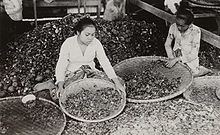tr
kırıntılardaki isimler


Damaroň filipínská (Agathis philippinensis, tagalog: Almasiga nebo Almaciga, syn. Agathis dammara[1]) je druh velkého pralesního jehličnatého stromu z čeledi blahočetovité. Pochází z Filipín a je zdrojem ceněného dřeva a pryskyřice, byť v současnosti je těžba tohoto stromu zakázána. Damaroně existovaly již v druhohorní juře a patří tak mezi tzv. živoucí zkameněliny.
Damaroň filipínská je velký jehličnan vyskytující se ve smíšených lesích tropického pásma na ostrovech Filipín. Vytváří až 65 metrů vysoký nevětvený kmen a tyčí se nad úroveň okolního lesa i 40 a více metrů. Na rozdíl od většiny jehličnanů, které mají jehličí (jehlicovité listy), damaroň filipínská má ploché, kožovité a podlouhlé listy. Samičí stromy mají kulovité a samčí válcovité šištice.
Její dřevo bylo vysoce oceňováno a používáno od koloniálních dob devatenáctého století. Kromě dřeva je tento strom zdrojem velmi hodnotné pryskyřice (tzv. Manila copal). Obliba a intenzivní těžba dřeva měla za následek rapidní úbytek damaroňových lesů.
Podle Červeného seznamu patří mezi zranitelné druhy, je tedy závislý na ochraně. Pro damaroň je největší hrozbou nadměrná těžba dřeva, pryskyřice, které tento druh v minulosti téměř zlikvidovaly, a samozřejmě také místní tajfuny a vypalování pralesů pro místní zemědělce.
V současnosti je těžba tohoto stromu na Filipínách zakázána, byť ke kácení nadále dochází. Damaroň patří mezi druhy vysazované v rámci obnovy lesů.
Damaroň filipínská (Agathis philippinensis, tagalog: Almasiga nebo Almaciga, syn. Agathis dammara) je druh velkého pralesního jehličnatého stromu z čeledi blahočetovité. Pochází z Filipín a je zdrojem ceněného dřeva a pryskyřice, byť v současnosti je těžba tohoto stromu zakázána. Damaroně existovaly již v druhohorní juře a patří tak mezi tzv. živoucí zkameněliny.
Ang almasiga (Agathis philippinensis) ay isang uri ng punungkahoysa kabundukan sa pilipinas. Ang kahoy na ito na tuwid at mataas ay siyang pangunahing pinagkukunan ng sahing na ginagawang insenso.Isa na itong nanganganib na uri ng punong kahoy sa ating bansa dahil sa pag uuling sa kabundukan.May ilan pa nitong matatagpuan sa Sierra Madre sa lalawigan ng Quezon, Aurora, Nueva Viscaya at Nueva Ecija
![]() Ang lathalaing ito na tungkol sa Biyolohiya ay isang usbong. Makatutulong ka sa Wikipedia sa nito.
Ang lathalaing ito na tungkol sa Biyolohiya ay isang usbong. Makatutulong ka sa Wikipedia sa nito.
Agathis dammara, commonly known as the Amboina pine or dammar pine,[3] is a coniferous timber[4] tree native to Sulawesi, the Maluku Islands and the Philippines.[1]

Agathis dammara is a medium-large conifer up to 60 metres in height found in tropical rainforests, growing from sea level to very high mountainous regions where it becomes extremely stunted. It belongs to the southern hemisphere family Araucariaceae, widespread throughout the entire Mesozoic, emerging about 200 million years ago. An extinct genus, Protodammara (which appeared long ago, during the Mesozoic), derives its name from this tree. This tree is a source of dammar gum, also known as cat-eye resin.
When first discovered and listed as a species it was placed in the genus Pinus (Lambert, 1803), and then later with the firs, Abies (Poir 1817), and then with its own genus, Dammara. It was first recognised as being part of Agathis in 1807, when it was listed as Agathis loranthifolia, and beyond that with species names beccarii, celebica and macrostachys, although it acquired many more names before dammara was settled on.
Agathis celebica and Agathis philippinensis were previously considered distinct species but since 2010 have been synonymous with Agathis dammara.[1]
Agathis dammara, commonly known as the Amboina pine or dammar pine, is a coniferous timber tree native to Sulawesi, the Maluku Islands and the Philippines.
Agathis philippinensis (Almaciga ou Dayungon) est une espèce d’Agathis originaire des Philippines, de Sulawesi et Halmahera. Il se rencontre dans la forêt tropicale humide de plateau entre 450 et 2200 m d'altitude, rarement aussi bas que 250 m dans le Nord de Luçon.
C'est un grand conifère sempervirent atteignant plus de 65 m en hauteur avec une écorce grise colorée et lisse. Les feuilles sont ovales, 4 à 6 cm de long et 1,5 à 2 cm de large sur les arbres adultes, contre 11 à 13 cm de long et 4,5 à 5 cm de large sur les jeunes arbres.
Les cônes polliniques mesurent 25 à 45 mm en longueur et 10-11 mm de large.
Agathis philippinensis (Almaciga ou Dayungon) est une espèce d’Agathis originaire des Philippines, de Sulawesi et Halmahera. Il se rencontre dans la forêt tropicale humide de plateau entre 450 et 2200 m d'altitude, rarement aussi bas que 250 m dans le Nord de Luçon.
Agathis philippinensis is een insect dat behoort tot de orde vliesvleugeligen (Hymenoptera) en de familie van de schildwespen (Braconidae). De wetenschappelijke naam van de soort werd voor het eerst geldig gepubliceerd door Bhat & Gupta in 1977.
Agathis philippinensis là một loài thực vật hạt trần trong họ Araucariaceae. Loài này được Warb. mô tả khoa học đầu tiên năm 1900.[1]
Agathis philippinensis là một loài thực vật hạt trần trong họ Araucariaceae. Loài này được Warb. mô tả khoa học đầu tiên năm 1900.